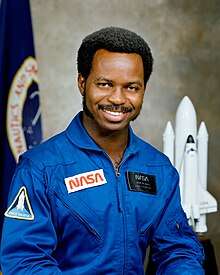
Ronald Erwin McNair was born in Lake City, South Carolina, October 21, 1950. He was nicknamed Gizmo, because he loved technical things and space, including a fascination with the Russian satellite Sputnik (1957), and the Star Trek TV show. McNair was involved in sports, played the saxophone, and graduated high school valedictorian in 1967.
In 1971, McNair received a bachelor’s degree in Physics from North Carolina A&T State University. He was awarded a Ford Foundation Fellowship to attend Massachusetts Institute of Technology (MIT). McNair earned a Ph.D. in Physics, with a specialization in laser research, at the age of 26. After MIT, Dr. McNair joined the Hughes Research Laboratories as a physicist and expert in chemical and high-pressure lasers. He developed lasers for space satellite communication, and two years later he became one of NASA's astronaut candidates.
By 1979, McNair qualified for an assignment as a Mission Specialist Astronaut and assigned to his first mission aboard the Challenger at Kennedy Space Center on February 3, 1984. Dr. McNair was the second African American to reach space. As a mission specialist, one of his responsibilities included operating the payload projects and experiments. While McNair first mission on the Challenger was a success, landing February 11,1984.
On Jan. 28, 1986, Ronald E. McNair along with six other crew members died tragically when the Space Shuttle Challenger exploded after its launch from Kennedy Space Center in Florida. The explosion occurred 73 seconds after lifting-off. Ronald E. McNair died at the age of 35, but left a long legacy on aspiring scientists.
The Challenger crew members were honored the Congressional Space Medal of Honor by President George W. Bush. And most notably, the Ronald E. McNair Postbaccalaureate Achievement Program was named after Dr. McNair as a federal TRIO program.
Source: biography.com